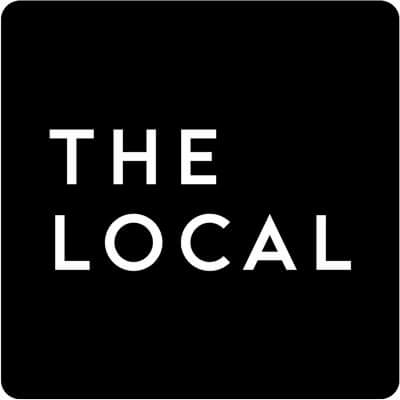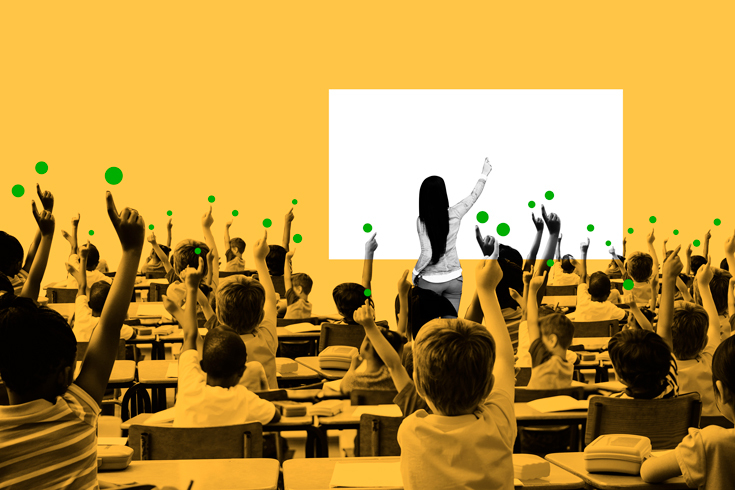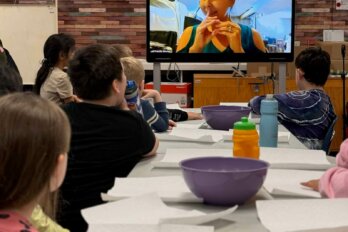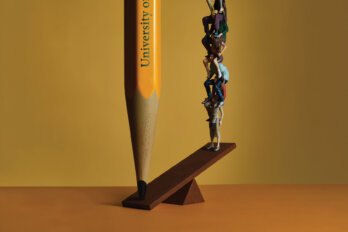
This story was originally published as “The Other Epidemic in Toronto’s Schools” by our friends at The Local. It has been reprinted here with permission.
“You’re talking to someone who’s throwing in the towel, a little bit.”
Kim Fry is leaving Ontario and maybe—just maybe—leaving teaching. Having lived in Toronto since 1994 and taught for the Toronto District School Board (TDSB) for the last eight years, Fry has felt the growing pressures of being a teacher in a city where the foundations of education funding have been crumbling for decades and a sense of powerlessness has burned out the workforce. “I just want to be in a place where I’m impacting things a little bit more,” she says, describing her family’s plans to move to Nova Scotia next year.
Before the pandemic, Fry had been uncertain about whether to stay or go. She has roots in the city: her daughter grew up here, and in 2009, Fry helped found a small community school, an experience that inspired her to become an elementary teacher. She’s also an active member of her teachers’ union, whose activism once excited her.
But, with COVID-19, her decision became a lot clearer.
“I just feel like Ontario has become a very unaffordable place to be,” she says. “We don’t own a home, and given all the cuts to education, and given . . . a complete lack of planning for affordable housing that’s been happening for decades now, the cuts to daycare, child care, cuts to public transit, and then these cuts coming to education . . . it’s been a slow chipping away in Ontario.”
“I’m not saying it’s amazing in Nova Scotia,” she adds. “But at least, in Nova Scotia, it’s at a scale I feel I can impact it better.”
Fry’s departure from teaching in Toronto is unsurprising—in fact, it’s a desire currently echoed by many. In a CBC questionnaire to thousands of teachers in eastern Ontario and Atlantic Canada, a third of respondents described considering retirement or a change in profession.
Since the beginning of the pandemic, teachers have described being exhausted, confused, and often unable to follow physical distancing guidelines because of class sizes. In early November, teachers at one school in Scarborough refused to work out of fear for their health after nine staff and two students contracted COVID-19. The outbreak sent fifty-eight people into self-isolation. As of mid-November, there were a total of 3,800 school-related COVID-19 cases in Ontario. Teachers, parents, and students are wondering why the province didn’t plan earlier—and better—for the return to school in September. But the problem goes back much further than the start of the pandemic: when COVID-19 arrived, Toronto’s education system had already been in crisis for twenty years.
Chronic underfunding rooted in policies from the late 1990s, coupled with cuts by the current provincial administration, have hit Toronto particularly hard because of its sheer size and capacity. Just last year, the TDSB had to implement $67.8 million worth of cuts, the majority of which were the result of a reduction in provincial funding.
The board’s emaciated state and the provincial government’s austerity agenda in turn informed their response to COVID-19 in schools, forcing educators like Fry to make increasingly difficult decisions about their place in Toronto’s education landscape.
Melissa Radomsky is no stranger to difficult decisions. A teacher at one of the TDSB’s Model Schools for Inner Cities—a program created to support students in low-income communities—Radomsky is now in her twenty-first year of teaching. Last year, she was diagnosed with a precancerous condition, but this year, despite her diagnosis and having asthma, Radomsky is teaching a class of twenty-five in person.
“I love my job. I put off having a hysterectomy because I love my job,” Radomsky says, describing the aftermath of her diagnosis last year.
When COVID-19 struck, she had to grapple with the prospect of losing that love. Ultimately, the uncertainty of virtual schooling and the lack of advance notice by the TDSB—through no fault of its own, as the province rejected the board’s plans for return to school multiple times—presented too grave a burden for Radomsky’s mental health.
“People didn’t get their assignments sometimes until the day before they started teaching,” she says. “The unknown of what your assignment was going to be, when you were going to get it, who your principal is going to be, how many kids you are going to have . . . I personally couldn’t wrap my brain around it—and I was concerned I wouldn’t make it through the year.” Going back into the classroom felt like a more manageable risk for Radomsky because she teaches in a large enough space to maintain some safe distance and knows her principal and community very well. But it was still terrifying.
Then she was assigned a grade four/five/six split class. “I have never even heard of a triple split, except in special-education classes. So I was like . . . How?”
Radomsky describes split grades as effectively being double—or, in her case, triple—the curriculum and paperwork, given that learning expectations differ from grade to grade. Split grades also mean that students don’t receive as much attention and feedback as they would in a single grade. Of her twenty-one years teaching, Radomsky estimates that sixteen involved teaching split-grade classes.
Data acquired by The Local from the previous Liberal administration’s Ontario Class Size Tracker (the current government isn’t publishing this data) shows that the number of split classrooms in the TDSB has grown significantly over the last two decades. Between 2003 and 2016, the period for which data was recorded, there was a 52 percent increase in the number of split-grade classes from junior kindergarten to grade three, with a total of 2,813 split-grade early primary classes at last count. In contrast, there was a 36 percent decrease in the number of single-grade classes. At last count, the data suggests that, up to grade three, there was a greater number of split-grade classes than of single-grade classes. The ministry of education did not respond to The Local’s request for comment on the rise in split-grade classes.
As a junior-grades teacher, Radomsky also had no class-size cap before the pandemic started—her largest-ever class was thirty-three students. Now, she thinks the twenty-seven-student cap for junior grades during the pandemic is unmanageably high, especially for teachers working in smaller spaces.
In a normal year, split grades and large class sizes stretch teachers thin, putting additional pressure on a system that has already cut teacher support and additional services deemed expendable by the province. During the COVID-19 pandemic, these conditions have proven to be overwhelming in an entirely new way.
Now, despite her love for her work, Radomsky dreams of retirement—a goal that’s still a decade away and something she hadn’t thought of seriously before the pandemic began. If she won the lottery, she jokes, she’d be gone tomorrow.
In 1995, then Ontario education minister John Snobelen was caught on video explaining his plan to “create a useful crisis” in order to shift public perception of the state of education in the province and push legislation that models education as a business. Now, twenty-five years on, his words are a prescient reflection of the current provincial Conservative leadership’s handling of the pandemic.
Teachers taking on double their workloads and stretching to fill multiple roles aren’t a product of this moment in isolation or the collateral damage of cuts to education: they are a purposeful feature of Bill 160, which passed in 1997, under then premier Mike Harris, and has come to shape education in Ontario.
Among its many impacts, Bill 160 took school-board funding out of the hands of the boards themselves in favour of a top-down model where funding was allocated by the province. Prior to the bill, funding for school boards was a mix of provincial provisions and taxes levied on local taxpayers by individual school boards. Those taxes allowed for services beyond the ones funded by the provincial government, and the money raised by urban school boards was significantly higher than that of their rural counterparts—this addressed the greater costs and unique demands in urban school boards, like ESL programs, supports for students in inner-city schools, maintenance costs, and special-education programs.
But the bill eliminated the taxes as part of a broader aim to reduce income tax in Ontario, says Hugh Mackenzie, a leading researcher on education funding in Ontario at the Canadian Centre for Policy Alternatives. “By far the hardest-hit school board in Ontario was the Toronto board: the funding formula provided for about 20 percent less spending than the board had been implementing.”
Bill 160 created a significant mismatch between money coming from the province and the realities of spending on the ground. In order to plug the holes in the system, funding was taken from activities considered to be “nonessential” and, in some cases, used to keep classrooms running.
“It dramatically reduced the scope of what was considered to be education provided by the school board, in the system across Ontario and particularly in Toronto,” Mackenzie adds. “Pretty much anything that a school board did that didn’t involve a teacher standing in front of thirty students and writing on a blackboard was not funded.”
Since then, libraries, outdoor education, the arts, subsidized school meals, technology in classrooms, building repairs, special education, and medical, psychological, and social resources in Toronto schools have consistently taken hits.
Some aspects of education funding improved in the months and years after the bill was passed—in part due to the resulting teachers’ strike, the largest in Canadian history, carried out by 126,000 teachers province-wide, and in part due to a change in provincial administration. Some funding was reinstated, though not to the levels seen prior to Bill 160.
But the core funding formula was never addressed—likely, Mackenzie believes, because there were newer, “sexier” political issues for the Liberals to campaign on. When full-day kindergarten and smaller elementary class sizes were instituted under that administration, they put greater pressure on budgets that were already stretched thin. This is the unstable foundation that has exacerbated the harm caused by premier Doug Ford’s further cuts and, now, by COVID-19.
“All of the weaknesses in the formula, the inadequate funding for technology, the inadequate funding for supports for teachers, the inadequate funding for issues that are raised by students at risk, all of those things were left in place,” Mackenzie says. “So, effectively, what we walk into the world of COVID-19 with is significantly more students at significantly greater risk with no funding for it.”
The TDSB as a whole has been feeling the burden of this disparity. Most of the teachers The Local spoke with emphasized that they didn’t blame the board, which they said was doing all it could in response to decisions by the province.
“We recognize that these are stressful times, not only for teachers as front line workers but for all of our staff who are supporting our schools to continue learning and keep everyone safe,” says Ryan Bird, spokesperson for the TDSB. “This is on top of the stresses in our personal lives as the pandemic continues.”
“Where possible, we’re trying to take things off teachers’ plates outside of the classroom” he adds, citing the Employee Assistance Program as a support resource available to teachers.
Beyond class sizes, teacher hiring, and funding for specialized programs—all of which have impacted the state of the COVID-19 education crisis—virtual schooling has proven a prime example of this instability in action. Many TDSB teachers have described virtual learning as an organizational disaster, and the roll-out of virtual teaching betrays a series of gaps in its implementation, beginning with teachers’ access to technological resources.
“Right now, every virtual school teacher is forced to teach on a platform that . . . requires a lot of intensive preparation,” says Beyhan Farhadi, a secondary-school teacher and postdoctoral researcher currently working on a book about e-learning and inequality in the TDSB.
Unpreparedness for virtual schooling can be the result of inexperience with the platform, but it can also be the product of inadequate planning, training, and access to resources on a provincial level. When virtual schooling was introduced, Farhadi explains, “there wasn’t a concerted effort to actually purposefully use the technology in order to improve teaching practice. There was never a conscious effort to determine what those best practices were, to collect that information.”
Underfunding education has meant a reduction in professional-development opportunities, including access to technological training and resources. But the impact of austerity on virtual learning goes one step further, Farhadi posits. “In [the province’s] engagement with online learning, the pattern has been that online learning has been used to cut costs. Online learning can work if we are funding it appropriately. But funding it is apparently as expensive—if not more expensive—than face-to-face learning.”
Farhadi objects to the provincial government’s separation of virtual and in-person learning, arguing that most students can achieve success in a virtual learning environment only if they continue to engage with in-class learning as well—especially at the secondary-school level. “You still need physical infrastructure, you still need a student to be able to go into a physical environment to access their learning and receive support from an adult who can troubleshoot and motivate.”
Virtual learning also reinforces academic disparities based on class, race, and ability, she warns. “It doesn’t matter if you’ve got a computer and a laptop if you don’t have food security and housing security, if you don’t have access to in-person support that can meet the varying demands of adolescence.” And these supports, to both meet students’ needs and provide adequate resources to teachers, require investment.
To anti-austerity advocates, the unwillingness to invest in safer in-person schooling through the hiring of more teachers and implementation of smaller class sizes—and the push, instead, toward virtual learning—is part of the province’s broader aim to create another “useful crisis” that puts more learning online, something the Ford government had been advocating for since before the pandemic began. “This government made very clear that it wanted to move education online. And I believe that it is using the pandemic as a way to achieve that goal,” says Leslie Wolfe, president of the Ontario Secondary School Teachers Federation (OSSTF) Toronto. “If they valued face-to-face instruction, they could have invested the money to hire the teachers.”
Virtual learning presents two opportunities that align with the Ford government’s interests: first, to save money through larger virtual class sizes and less need to hire teachers; second, to potentially contract out the delivery of virtual learning to the private sector or make it available for purchase. This opportunity for profit strikes at the heart of what many Toronto teachers fear: an education system moving toward privatization, instituted provincially through vouchers or charter schools that will reinforce hierarchies of race and class.
While Toronto-specific data is unavailable, The Local’s analysis of data on enrolment and employment in private and independent schooling on a provincial level revealed that Ontario has one of the highest per-capita population of private-school educators in the country, second only to BC and 54 percent higher than the national rate. In 2018, there were 1,053 private or independent educators for every 100,000 people in Ontario; in comparison, there were only 163 for every 100,000 people in New Brunswick, the province with the lowest proportion of private educators.
Ontario’s per-capita enrolment of students in private schools was fourth highest in the country in 2014 and has since risen to third highest. While official data on class sizes in private schools is unavailable, analyses comparing the numbers of students and teachers indicate that private and independent schools in Ontario are likely benefiting from smaller class sizes than public schools can manage, making them more attractive to parents who can afford the tuition.
Enrolment in private or independent schools grew by 18 percent between 2000 and 2015 and continues to rise. This is despite an overall decrease in the number of school-age children in Ontario, which has led to a drop in public-school enrolment. A shift in enrolment in favour of private education means a loss of funding, resources, and employment for public educators, whose jobs are predicated on enrolment. The number of allocated secondary-school standard classroom teachers in the TDSB has fallen by nearly 200 since 2016, according to data provided to The Local by the OSSTF.
The cycle is vicious: if educators and students move from the public system to the private system, funding and support for public education decreases with falling enrolment. This reduction of resources then further disincentivizes participation in public education. With public schools also reliant on donations from parents to make up for gaps in funding, wealthy parents distancing themselves from the public-education system also means a reduction in fundraising.
Ultimately, the fear is that low- and middle-income students unable to afford private school will be stuck in underfunded and heavily neglected public schools with only the most basic classroom teaching while wealthy students will have access to well-funded private education stocked with extracurriculars, small class sizes, and additional supports that the Bill 160 funding formula gutted from public schools.
“The point, essentially, [is for the government to] frame these cuts as incontestable, as economic inevitabilities rather than political decisions, which is what they are,” says Julius, a middle-school teacher conducting virtual schooling this year. “They’re ultimately very political decisions that are coming from a desire to challenge what this education system is capable of.”
Even before COVID-19 hit, Julius had experienced the impact of increasing class sizes firsthand. In 2018, they taught six classes of twenty-five students each; in 2019, there were thirty students per class; now, there are thirty-five—effectively a thirty-student increase per year. During the pandemic, this means that, in the forty-minute classes they have with thirty-five kids, they’re unable to spend any time supporting or engaging with students one-on-one. “I told the kids, even if I want to have a conversation with each of you, I would have max one minute and ten seconds. That’s it.”
Julius began their teaching career three years ago and has faced significant challenges in that time, but nothing quite like COVID-19. Like many others, they describe this year’s virtual schooling as a gruelling iteration of teaching that deprives teachers of the best parts of the job. “I’ve never said so many times that I want to quit in a year,” they say. “When you’re around the kids, it’s hard to be apathetic: they’re so full of life, and there’s a desire to connect with them. But, when you’re doing the work on your own, it’s a bit of like—What am I doing this for? What difference does it make?”
For Julius and for so many other teachers—both in-person and online—teaching during COVID-19 has been profoundly lonely. Behind all the chaos of returning to school, organizing and administering online learning, and constantly waiting for the next piece of bad news from the board and the province, there’s a more fundamental truth to the pandemic: there were too many gaps in Toronto’s education system for it to ever be able to handle a crisis like COVID-19.
Until now, the main thing holding these gaps together—preventing the system from tearing wide open—were educators and support staff advocating for the future of a generation. But there’s only so far you can stretch them before they start to fall apart.





